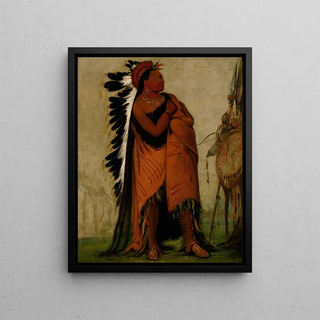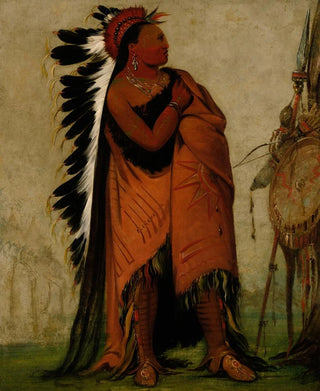Art print | E-Hee-A-Duck-Ce-A The one who ties his hair back - George Catlin


View from behind

Frame (optional)
In the fascinating universe of art, some works transcend the simple frame to become witnesses of a culture, an era, or an emotion. "E-Hee-A-Duck-Ce-A Celui qui attache ses cheveux avant" by George Catlin is one of these iconic pieces. This artwork, which captures with rare intensity the essence of Native American identity, immerses us in a world where art and history intertwine. Through Catlin's gaze, we discover not only a portrait but also a visual narrative that evokes the traditions and rituals of Indigenous peoples of America. The art print of this piece allows for an appreciation of the depth of the representation and initiates a dialogue on the cultural richness that Catlin sought to preserve.
Style and uniqueness of the work
George Catlin's style is characterized by meticulous attention to detail and a vibrant color palette that breathes life into his subjects. In "E-Hee-A-Duck-Ce-A," the depiction of the character is both realistic and imbued with a certain spirituality. Catlin does not merely paint a man; he immortalizes an emblematic figure, dressed in traditional ornaments, symbolizing his heritage and dignity. The artist employs techniques that highlight the textures of clothing and accessories, making the sensation of touch almost palpable. The subject's gaze, both proud and introspective, draws the viewer in and invites contemplation of the story behind the face. This blend of realism and symbolism gives the artwork a depth that resonates with anyone who lingers on it.
The artist and his influence
George Catlin, as an artist and ethnographer, played a crucial role in documenting Native American cultures in the 19th century. His commitment to representing Indigenous peoples with respect and authenticity made him an essential figure in the history of American art. At a time when stereotypes and distorted representations were common, Catlin chose to give a voice to those who were often silenced. His work not only contributed to the preservation of these cultures,

Matte finish

View from behind

Frame (optional)
In the fascinating universe of art, some works transcend the simple frame to become witnesses of a culture, an era, or an emotion. "E-Hee-A-Duck-Ce-A Celui qui attache ses cheveux avant" by George Catlin is one of these iconic pieces. This artwork, which captures with rare intensity the essence of Native American identity, immerses us in a world where art and history intertwine. Through Catlin's gaze, we discover not only a portrait but also a visual narrative that evokes the traditions and rituals of Indigenous peoples of America. The art print of this piece allows for an appreciation of the depth of the representation and initiates a dialogue on the cultural richness that Catlin sought to preserve.
Style and uniqueness of the work
George Catlin's style is characterized by meticulous attention to detail and a vibrant color palette that breathes life into his subjects. In "E-Hee-A-Duck-Ce-A," the depiction of the character is both realistic and imbued with a certain spirituality. Catlin does not merely paint a man; he immortalizes an emblematic figure, dressed in traditional ornaments, symbolizing his heritage and dignity. The artist employs techniques that highlight the textures of clothing and accessories, making the sensation of touch almost palpable. The subject's gaze, both proud and introspective, draws the viewer in and invites contemplation of the story behind the face. This blend of realism and symbolism gives the artwork a depth that resonates with anyone who lingers on it.
The artist and his influence
George Catlin, as an artist and ethnographer, played a crucial role in documenting Native American cultures in the 19th century. His commitment to representing Indigenous peoples with respect and authenticity made him an essential figure in the history of American art. At a time when stereotypes and distorted representations were common, Catlin chose to give a voice to those who were often silenced. His work not only contributed to the preservation of these cultures,






